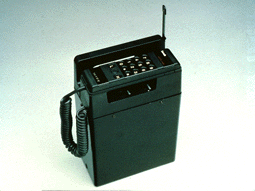The Early Mobiles
 Since 1951 phones are being installed in the cars. Calls were dispatched via manual operated exchanges, but the system had many problems. For instance, one had to know the location of the car and there was no privacy---other subscribers with car phones were able to listen to each other's conversation.
Nordic countries decided to develop a more advanced mobile telephone system in the late seventies.
The Nordic Mobile Telephone system (NMT) was put into public service at the turn of the year 1981/82. At that time it covered major parts of Denmark, Finland, Norway and Sweden. The goal was to make the NMT system function, as much as possible, just like the ordinary telephone system.
The mobile telephone exchange, a computer operated digital exchange, automatically registered where the cellphone was located. So the calling person did not have to worry about the location--i.e. in which of the Nordic countries the cellphone was, as the mobile subscriber was always reachable at the same number.
The NMT system was equipped with several advanced functions, that were part of the ordinary telephone network later. Among other things was 'call forwarding'--if no answer--to another phone number and 'abbreviated dialling' of frequently used numbers. Besides this, it broke new grounds which helped the development of the digital GSM cellular system that was introduced later on and became cellular market leader.
The cellphone shown below is a 1982 NMT 'portable' cellular mobile telephone manufactured by Ericsson, Sweden.
Since 1951 phones are being installed in the cars. Calls were dispatched via manual operated exchanges, but the system had many problems. For instance, one had to know the location of the car and there was no privacy---other subscribers with car phones were able to listen to each other's conversation.
Nordic countries decided to develop a more advanced mobile telephone system in the late seventies.
The Nordic Mobile Telephone system (NMT) was put into public service at the turn of the year 1981/82. At that time it covered major parts of Denmark, Finland, Norway and Sweden. The goal was to make the NMT system function, as much as possible, just like the ordinary telephone system.
The mobile telephone exchange, a computer operated digital exchange, automatically registered where the cellphone was located. So the calling person did not have to worry about the location--i.e. in which of the Nordic countries the cellphone was, as the mobile subscriber was always reachable at the same number.
The NMT system was equipped with several advanced functions, that were part of the ordinary telephone network later. Among other things was 'call forwarding'--if no answer--to another phone number and 'abbreviated dialling' of frequently used numbers. Besides this, it broke new grounds which helped the development of the digital GSM cellular system that was introduced later on and became cellular market leader.
The cellphone shown below is a 1982 NMT 'portable' cellular mobile telephone manufactured by Ericsson, Sweden.
